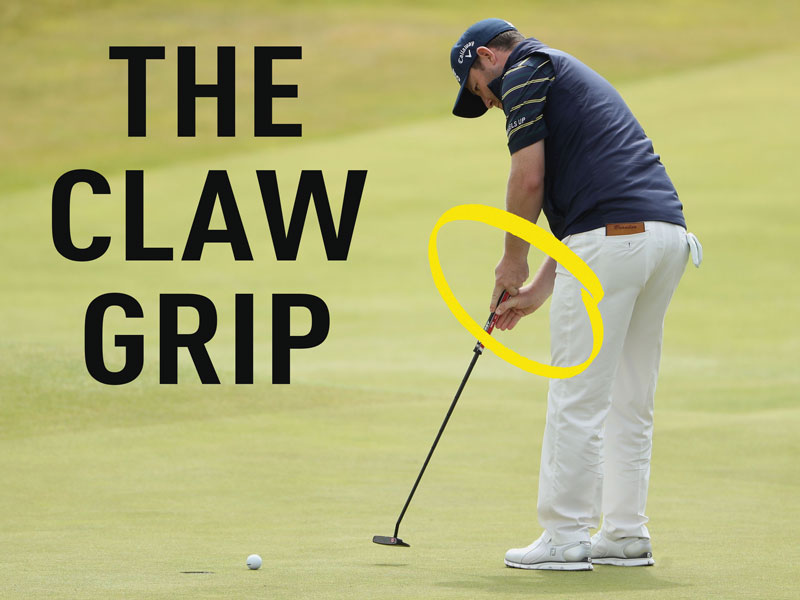Jordan Spieth Tips: 5 Secrets To Being A Complete Player


Following his triumph in the US Open at Chambers Bay we have put together these Jordan Spieth tips to learn how to become a complete player
In winning his second major at Chambers Bay, we saw Jordan Spieth keep his golf game and his temperament together under pressure. In this Jordan Spieth tips feature, he explains the keys to his game and how they could help you too...
1 Putt Cross-Handed
I switched from a conventional grip to cross-handed six years ago, and it’s made a huge difference in my putting. How huge? I finished first or second in four of the seven most important putting stat categories last year and picked up a third of a stroke on the field in each round, just on the greens. Older guys on Tour tell me that if they could go back and change one thing about their game, it’d be to learn how to putt cross-handed from the beginning. It truly is the best way to roll it.
Placing your left hand below your right on the handle makes it easier to set the face square to the line at address and keep it square during your stroke. My cross-handed putting technique is a three-step process: I settle in, find a trigger, and simply keep my left wrist flat. Here’s how it works.
To set up for a cross-handed stroke, start off by holding the putter in your right hand only, with your palm facing the target. Then place the putter head behind the ball and aim it straight down your target line.
Get the Golf Monthly Newsletter
Subscribe to the Golf Monthly newsletter to stay up to date with all the latest tour news, equipment news, reviews, head-to-heads and buyer’s guides from our team of experienced experts.
Once you have aimed the putter head properly, set your feet so your weight is evenly balanced and place your left hand on the lower part of the putter grip.
Remember that when you place your left hand on the grip, your left shoulder will want to duck down a bit below your right shoulder — that’s a move you don’t want! Make sure your shoulders are level at set-up. If you have someone who can check your shoulder position for you, that’s great, but practising in front of a mirror is also a good option.
Read Rory McIlroy's Putting Tips
2 Make Better Reads
Green reading is one of the toughest parts of the game. If you aren’t very good at it, it’s probably because you don’t have a routine that gives you a 360-degree view of a given putt. Like most weekend players, you sort of ‘eyeball’ the line without any real idea of what you’re looking at. Or perhaps you read a putt one way on one hole, then use a completely different technique on the very next hole. Here’s how I read greens.
1 Look at the putt from behind the ball
Squat down and move your eyes from the ball to the hole, as though it were a straight putt. This initial read gives you a starting point, creating a more specific target. As you do this, split your read in half: visualise how fast the ball must roll during the first half of the putt, and how it will slow as it nears the hole.
2 Walk to the opposite side of the hole on the low side of the putt. Use the low side to gauge the slope with your feet. You’ll get a better sense of the overall tilt of the green — and break of the putt — than you will walking on the high side.
3 Look at the putt from behind the hole. Everyday players almost never do this. They should! Your eyes will take in more information about the slope. Sometimes you’ll find that your initial read was incorrect.
4 Return to behind the ball. Again, walk on the low side, paying close attention to what your feet feel.
5 Find the ‘breaking point’. Now that you have seen the putt from both sides of the hole and felt the green with your feet, you will be able to identify where the putt’s break will start. This apex, or ‘breaking point’, is your target. Burn the spot into your mind’s eye!
6 Focus on the second half of the putt. Finally, look at the putt from the apex to the hole. Picture how fast the ball should roll in this part of the putt in order to trickle into the hole. Remember that in general, the ball will slow down as it approaches the hole.
3 Groove A ‘Go To’ Tee Shot
If your A-game is AWOL off the tee, you can still go low — if you have a go-to shot. I love hitting a punch-cut driver, a reliable, pressure-proof tee shot. To start, pick out a target on the left edge of the fairway and align your club and body to it. Begin with the clubface, then make sure your feet, hips and shoulders are square to the target line, not open (the common mistake with this shot). Once you’re set up square, make two critical moves: position the ball a bit further back in your stance than your normal tee-ball position, and tee the ball a little lower than normal. These two tweaks will keep the ball down and minimise sidespin. Now swing at about 75% of full speed. Trust me, you don’t need to kill it – all you want is a controlled motion that puts the ball in the middle of the fairway. To further increase your odds of solid contact, make your swing about three-quarters its normal length.
Finally, here’s an optional move if you’re a handsy player: at impact, keep your left wrist square to the target line to ‘hold off’ the clubface’s rotation. This creates cut spin, which will fade the ball to the centre of the fairway.
4 Master the High Long Iron
A number of times during a typical round you’ll need to take a long iron or hybrid and hit a high ball that drops softly and sharply. It’s my favourite tee shot on tight fairways, when I need to place the ball between some hazards or when hitting into the green on par 5s and long par 3s. I struggled with the high long-iron shot for many years until I figured out the following foolproof method.
When you take your address position, play the ball about two inches closer to your left heel than usual; the ball should roughly align with your left armpit. Although the ball is up, don’t make the mistake of setting your body ‘behind’ the ball as much as you would with a driver. This can drop your right shoulder much lower than your left, which is the fast track to fat contact with a long iron. Instead, keep your shoulders level and feel as though your chest is over the ball, not behind it.
Why play the ball up? Well, with the ball forward of centre, you automatically create a flatter swing arc and add loft to the clubface through impact. These two things help you hit the ball high with lots of shot-stopping spin.
An important reminder when working on this shot is that since your set-up is the same but the ball is further up in your stance, your body will want to ‘bottom out’ the club a few inches behind the ball. Make a strong weight shift to your front leg on your downswing, which will free the club to find the ball.
Hone this shot on the range before using it on the course. To promote good contact, hit practice shots with balls teed up just a tiny bit higher than a normal lie. Then move on to regular fairway lies.
5 Master the ‘one-hop-and-stop’ wedge
Some recreational players are intimidated by ‘tricky’ half shots from 40 to 60 yards. But after practising this tip, these short shots will be as automatic as throwing darts, and you’ll be knocking a lot of them to tap-in range. On these half wedges, I like to hit shots that hit the green, take a small hop, and then immediately stop. These are closer to miniature full swings than long chips. Apply more speed than finesse to get the spin needed to hop and stop, but not so much spin that your ball grabs and pulls backwards and further away from the pin. Use the following technique and practise with different wedges to see how much carry you get with each club.
Read more tips on how to create spin
1 Address
Set your weight slightly forward (about 60% of it on the front foot), then open the clubface slightly and narrow your stance by a few inches.
2 Backswing
Make a chest-high backswing while hinging your wrists to the maximum. This extra hinge offers added fizz at impact from your shortened top position. Let your shoulders turn as they normally would, but keep your hips still and your weight over your front foot to produce more of a descending blow.
3 Downswing
Although you shortened your backswing, this is not a slow-swing shot. Make an aggressive downswing while releasing all the hinge in your wrists. Feel as if your right arm and the shaft form a straight line at impact.
4 Through-swing
Hold your left wrist angle through impact so that the logo on the back of your glove faces the target in an abbreviated finish. This move creates cut spin to stop the ball after its first bounce, as well as a lower-than-normal trajectory, which heightens accuracy.

In July 2023, Neil became just the 9th editor in Golf Monthly's 112-year history. Originally working with the best coaches in the UK to produce instruction content, he has also presented many Golf Monthly videos looking at all areas of the game from Tour player interviews to the rules of golf.
Throughout his time with the brand he has also covered equipment launches that date back well over a decade. He clearly remembers the launch of the Callaway and Nike square drivers as well as the white TaylorMade driver families, such as the RocketBallz! If you take a look at the Golf Monthly YouTube channel, you'll see his equipment videos dating back over a decade! He has also conducted 'What's In The Bag' interviews with many of the game's best players like Rory McIlroy, Dustin Johnson and Jon Rahm. Over the years, Neil has tested a vast array of products in each category and at drastically different price-points.
Neil is currently playing: Driver: TaylorMade Stealth Plus Fairway Wood: Titleist TSR2 Hybrid: Titleist TS3 Irons: PING Blueprint S (4&5), PING Blueprint T (6-PW) Wedges: Titleist Vokey SM7 50˚, 54˚, 60˚ Putter: Odyssey Triple Track Ten Ball: Titleist Pro V1X
-
 'Welcome To The Club' - Tiger Woods Leads Praise For Rory McIlroy After Masters And Grand Slam Glory
'Welcome To The Club' - Tiger Woods Leads Praise For Rory McIlroy After Masters And Grand Slam GloryA host of famous sports stars and celebrities have been quick to praise the Northern Irishman after his incredible victory at Augusta
By Michael Weston Published
-
 'He Wouldn't Talk To Me' - Bryson DeChambeau Reveals Rory McIlroy Dynamic During The Masters Final Round
'He Wouldn't Talk To Me' - Bryson DeChambeau Reveals Rory McIlroy Dynamic During The Masters Final RoundAfter a disappointing Sunday at The Masters, DeChambeau shared that McIlroy was so focused en route to victory that the pair barely exchanged words all day
By Jonny Leighfield Published
